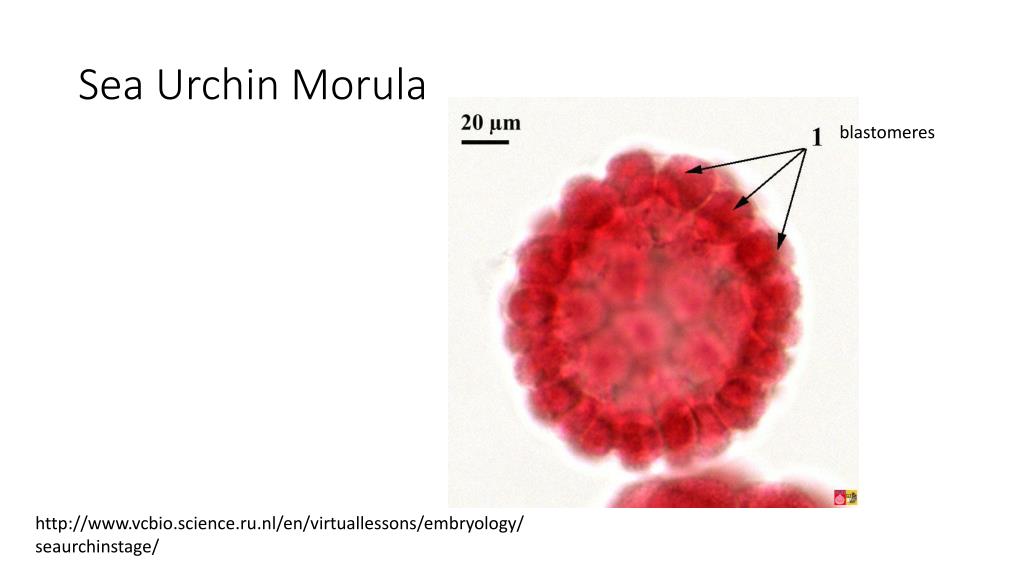

During the prism stage, a few cells from each coelomic pouch extend pseudopods toward the outer surface of the esophagus. Although most of these cells develop into pigment cells or blastocoelar cells, a small population is committed to differentiate into esophageal muscle cells. During gastrulation, Non-skeletogenic mesodermal (NSM) cells delaminate from the coelomic epithelium at the tip of the archenteron. In the sea urchin embryo, the development of circumesophageal muscles has been well characterized from a morphological point of view. In addition, a third lineage of muscle cells forms paired star-shaped muscles that were recently identified in the ectoderm of the mature Echinoidae plutei, but are absent in the Asteroidea and Holothuroidea larvae. These are distinguished from another type of endodermally-derived muscle cells that are located in the three myoepithelial sphincters that compartmentalize the archenteron.

Other transcription factors with an evolutionary conserved role in orchestrating myogenesis are members of the Forkhead (Fox) and Sry-related HMG box (Sox) families, members of the homeobox sine oculis (Six) family, the bHLH factors Twist and Myogenic Repressor ( MyoR), members of the MADS box family, such as the Myogenic enhancer ( Mef2) and the Serum Response Factor (SRF) Myocardin and members of the T-box family, Tbx1 and Tb圆.Įchinoderm larvae have a net of circumesophageal muscles of mesodermal origin that enable swallowing. elegans can efficiently activate myogenesis in 10 T1/2 cells. The control mechanism for muscle gene activation appears to be highly conserved, as MRFs from both the sea urchin and the nematode C. These mechanisms have served as a paradigm for transcriptional regulation since the discovery of myogenic regulatory factors (MRFs), which are able to convert undifferentiated non-mesodermal cells into muscle-like cells.

The molecular events that underlie myogenesis are well documented in several divergent species (for example, mouse and fly). Muscle development is a highly regulated process that relies on inductive signals to activate a cascade of regulatory events that direct cellular differentiation. The data presented here suggest a high level of conservation of the myogenic specification mechanisms across wide phylogenetic distances, but also reveal clear cases of gene cooption. Our findings have important implications in understanding the evolution of development of the muscle cell lineage at the molecular level. Conclusionsįrom this analysis, we are able to precisely define the regulatory and differentiation signatures of the circumesophageal muscle in the sea urchin embryo. Together, these data support a very early gastrula stage segregation of the myogenic lineage. Among them, a small group of cells within the FoxY domain, which also express FoxC and So圎, have been identified as plausible myoblast precursors. Our data allowed us to build a complete map of the Non-Skeletogenic Mesoderm at the very early gastrula stage, in which specific molecular signatures identify the precursors of different cell types. Moreover, using a combinatorial analysis of gene expression we followed the development of the FoxF/FoxC positive cells from the onset of expression to the end of gastrulation. The regulatory states of these domains were characterized in detail. Interestingly, evolutionarily conserved myogenic factors such as Mef2, MyoR and Six1/2 are not expressed in sea urchin myoblasts but are found in other mesodermal domains of the tip of the archenteron. The expression of the differentiation genes Myosin Heavy Chain, Tropomyosin I and II, as well as the regulatory genes MyoD2, FoxF, FoxC, FoxL1, Myocardin, Twist, and Tb圆 uniquely identify these cells. A few myoblasts are bilaterally distributed at the oral vegetal side of the tip of the archenteron and first appear at the late gastrula stage. Here, we present a comprehensive description of the development of the sea urchin larval circumesophageal muscle lineage beginning with its mesodermal origin using high-resolution localization of the expression of several myogenic transcriptional regulators and differentiation genes. As an invertebrate deuterostome that is more closely related to the vertebrates than other commonly used model systems in myogenesis, the sea urchin fills an important phylogenetic gap and provides a unique perspective on the evolution of muscle cell development. Although the morphology and later development of this muscle system has been well-described, little is known about the molecular signature of these cells or their precise origin in the early embryo. In sea urchin larvae the circumesophageal fibers form a prominent muscle system of mesodermal origin.


 0 kommentar(er)
0 kommentar(er)
